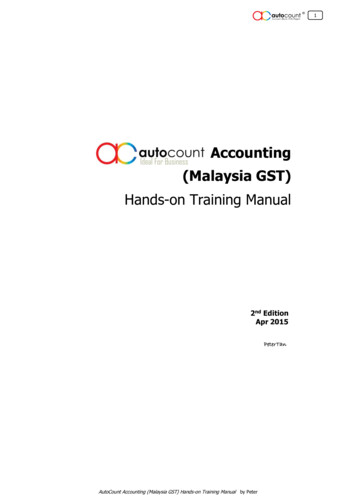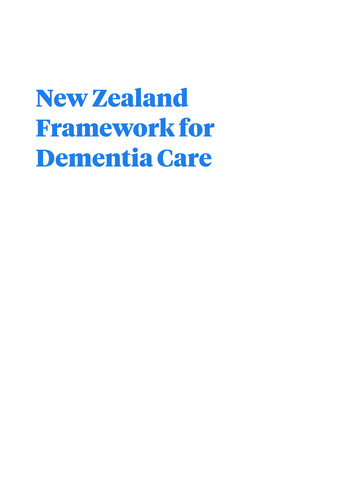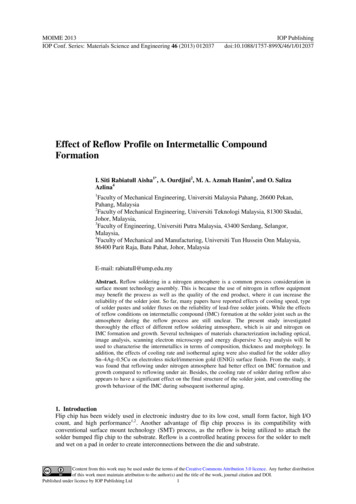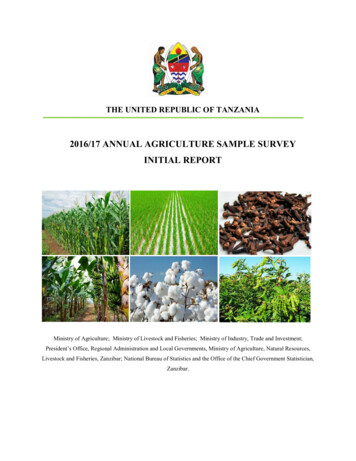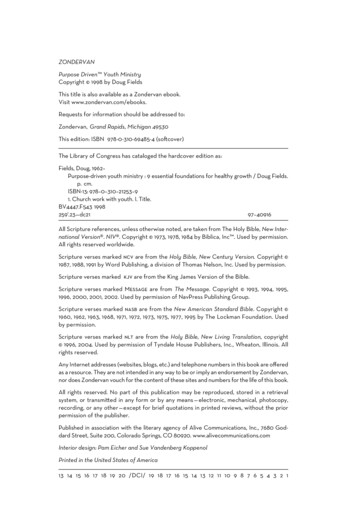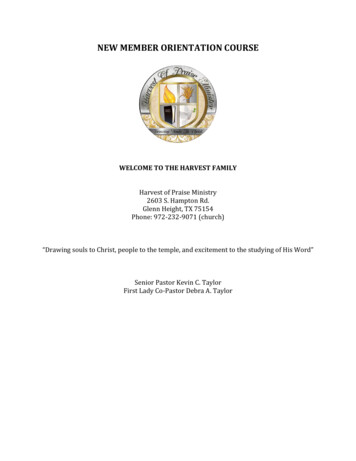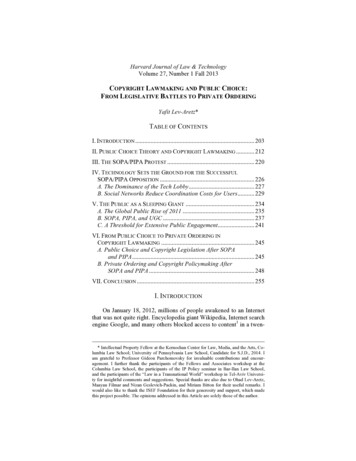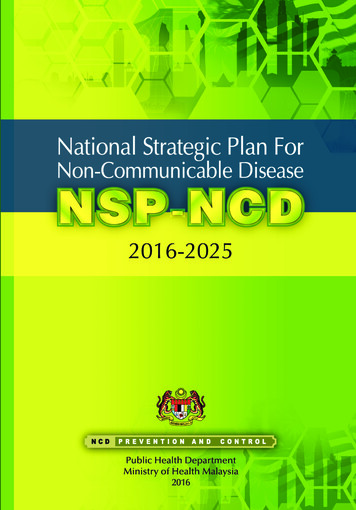
Transcription
Copyright Ministry of Health MalaysiaAll rights reserved. This book may not bereproduced, in whole or in part, in any formor means, electronic or mechanical, includingphotocopying, recording, or by any informationstorage an retrieval system now known orhereafter invented, without written permissionfrom publisher.First Edition 2016Suggested Citation:Ministry of Health 2016. National StrategicPlan for Non-Communicable Disease (NSPNCD) 2016-2025.Editor:Dr. Feisul Idzwan MustaphaPublished by:Non-Communicable Disease (NCD) SectionDisease Control DivisionMinistry of Health PutrajayaLevel 2, Block E2, Complex EFederal Government Administration Centre62590 PutrajayaMALAYSIATel: 603-88924409 Fax: 603-88924526Website: www.moh.gov.myISBN 978-967-0769-82-0
TABLE OF CONTENTExcerpt from the 11TH Malaysia Plan 2016-2020iiiMessage from the Minister of Health MalaysiaivMessage from the Secretary General, Ministry of Health MalaysiavMessage from the Director General of Health MalaysiaviExecutive Summaryvii1. INTRODUCTION012. NSP-NCD 2010-20142.1 Background2.2 Analysis of the Implementation of NSP-NCD 2010-20142.3 Burden of NCD in Malaysia020203043. NSP-NCD 2016-20253.1. Background3.2. NCD Targets for Malaysia3.3. Objectives of NSP-NCD 2016-2025080809104. OPERATIONALISING NSP-NCD 2016-20254.1. Background4.2. Summary of Action Plan and Initiatives4.2.1. National Strategic Plan for Tobacco Control 2015-20204.2.2. Policy Options to Combat Obesity in Malaysia 2016-20254.2.3. Salt Reduction Strategy to Prevent and Control NCD ForMalaysia 2015-20204.2.4. National Strategic Plan for Active Living 2016-20254.2.5. National Action Plan: Prevention and Harmful Use ofAlcohol 2013-20204.2.6. National Strategic Plan for Cancer Control Program2016-20204.2.7. Strengthening Chronic Disease Management atPrimary Care Level through the Enhanced PrimaryHealth Care (EnPHC) Initiative4.3. Main Activities under each Objective of NSP-NCD 2016-20254.3.1. Objective 1: To strengthen national capacity, leadership,governance, multi-sectoral action and partnerships toaccelerate country response for the prevention andcontrol of NCDs4.3.2. Objective 2: To reduce modifiable risk factors for NCDs andunderlying social determinants through creation ofhealth-promoting environments1111NSP-NCD 2016-202512121213141415151516iiii
4.3.3.4.3.4.4.3.5.Objective 3: To strengthen and orient health systems toaddress the prevention and control of NCDs and theunderlying social determinants through people-centredprimary health care and universal health coverageObjective 4: To promote and support national capacity forhigh-quality research and development for the preventionand control of NCDsObjective 5: To monitor the trends and determinants ofNCDs and evaluate progress in their prevention and control1616165. EMPOWERING MALAYSIANS THROUGH KOSPEN5.1. Background5.2. Evaluation of Phase 1 implementation5.3. Status of implementation171718186. MONITORING AND EVALUATION6.1. Global Level6.2. National Level6.3. National Indicators and Targets191919207. CONCLUSION22iviiNSP-NCD 2016-2025
EXCERPT FROM THE 11TH MALAYSIAPLAN 2016-2020“Focus area A - Achieving universal access toquality healthcare”Good health is essential for a good quality oflife. Consequently, the Government remainscommitted to achieving universal access toquality healthcare during the Eleventh Plan bycontinuing efforts to improve the fundamentalsof the health system. This means that everyMalaysian will have equal access to affordableand good quality healthcare services, whetherdelivered by public or private providers.“Intensifying Collaboration with Private Sector and NGOs to Increase HealthAwareness”Strategy A4 of the 11th Malaysia Plan 2016-2020 focused on measuresthat will be undertaken to reduce communicable diseases (CD) and noncommunicable diseases (NCD), which includes the provision of preventivehealthcare services and the promotion of a healthy lifestyle, where therole of the private sectors and non-governmental organisations (NGOs)are emphasised. The private sector will be encouraged to undertakecorporate social responsibility (CSR) programmes and to collaborate withthe Government in research and development. NGOs will be encouragedto provide health advocacy activities, health screening, and early healthinterventions, as well as to work with the private sector in carrying out healthrelated CSR programmes. Community participation in health promotionprogrammes, such as the use of public parks and recreational areas topromote healthy lifestyles will be encouraged. Intervention programmeswhere the community will be trained to promote health, such as KOSPEN,will continue to address lifestyle related diseases.*Chapter 4 : Improving Wellbeing For All (page 115-116).NSP-NCD 2016-2025iiiv
MESSAGE FROM THE MINISTEROF HEALTH MALAYSIAIt is an honour and a privilege for me to present the 10-year National StrategicPlan for Non-Communicable Diseases (NSP-NCD) 2016-2025. ThisStrategic Plan builds on the earlier NSP-NCD 2010-2014 and is presentedat the opportune moment when the world is acknowledging the impendingdanger of NCDs and their impact on the economy as well as productivity ofthe nation.The NSP-NCD was developed based on current global themes and mandatesfrom the World Health Organization (WHO). This latest edition of the NSPNCD will continue to provide the over-arching framework for strengtheningNCD prevention and control in Malaysia. This Strategic Plan is in line withthe Global Action Plan for the Prevention and Control of Non-CommunicableDiseases 2013-2020.The NCD situation in Malaysia is like that of an epidemic and must be dealtwith like any Public Health Emergency. The Ministry of Health (MOH) hastaken the lead in the formulation of this Strategic Plan to combat NCDs wherethe risk factors are already known and well described. The emphasis on thewhole-of-goverment and whole-of-society approach to NCDs is important ashealth is not only the MOH’s responsibility but also everyone’s responsibility.It relies on the support of all stakeholders and therefore I urge everyoneto work together to implement the recommended interventions and makeMalaysia a healthier place to live in.Malaysia aspires to be a developed nation by 2020 and a great nation by2025. Its greatest asset is its people, we Malaysians. We have to be aHealthy Nation first in order to reach those targets. Hence, we have to actnow to prevent our population suffering disability and premature deaths dueto NCDs, including for our children, who will reach early adulthood soon.This is the healthy future that we want for all Malaysians.Datuk Seri Dr S. SubramaniamMinister of HealthMalaysiaviivNSP-NCD 2016-2025
MESSAGE FROM THE SECRETARYGENERAL, MINISTRY OF HEALTHMALAYSIAI am delighted to share my thoughts on our National Strategic Plan for NonCommunicable Diseases (NSP-NCD) 2016-2025. Facts and figures fromour latest population-based health survey known as the National Healthand Morbidity Survey (NHMS) in 2015 showed that the prevalence of NCDrisk factors continue to rise. We now have an estimated 3.5 million adultMalaysians living with diabetes, 6.1 million with hypertension, 9.6 millionwith hypercholesterolemia and 3.3 million with obesity.The rapid increase in the number of people suffering from NCDs presentsone of the biggest challenges to the current healthcare system in Malaysia.Although much has been done for NCD prevention and control, there isscope for a more coordinated approach for better health returns. This willrequire multi-sectoral cooperation from the government, public and privatesectors as well as communities to build up an environment that enableshealthy living i.e. one back makes healthier choices easier for Malaysians.NCDs are preventable. It requires a shift in people’s attitudes and preferences.privilege behaviours such as the detrimental eating patterns, sedentarylifestyles and smoking among many Malaysians adds to the high burdenof NCDs in Malaysia. This is not the business of Ministry of Health alone.It has to be everyone’s business. This Strategic Plan calls for concertedefforts to address these risk factors and sets out directions that will shape anenvironment that is conducive to NCD prevention and control.Although the challenges related to NCDs that we face may seemoverwhelming, I am confident that the momentum that has been initiatedby these and other efforts will continue to build and spread throughoutthe whole-of-government and society as we come together to fight thesediseases and ensure that our communities promote healthy lifestyles.Dato’ Seri Dr Chen Chaw MinSecretary GeneralMinistry of Health MalaysiaNSP-NCD 2016-2025viiv
MESSAGE FROM THE DIRECTORGENERAL OF HEALTHMALAYSIAI am pleased to present the new edition of National Strategic Plan for NonCommunicable Diseases (NSP-NCD) 2016-2025 which sets out our rolein addressing the significant and increasingly challenging threats posed byNCDs in Malaysia. I wish to congratulate the Public Health Department forthe successful publication of this document.There is no doubt that the lifestyle in Malaysia has changed over the yearsas a result of urbanisation and globalisation. These in turn give rise to thedual burden of disease; increasing incidences of overweight, obesity andNCDs as well as micronutrient deficiencies. The number of people withNCDs such as diabetes, hypertension, cancers, and heart diseases keepsgrowing bringing the ‘Health of the Nation’ to a critical crossroad.NCDs are the leading cause of death and morbidity among adults inMalaysia, and have resulted in heavy emotional as well as financial toll on allof us. The increasing medical costs to treat patients with NCDs is of seriousconcern. If the trend of NCDs continues to rise, healthcare costs will not onlybe unsustainable, but the human costs would also be unimaginable.Over the next 10 years, we will focus on five strategic priorities that are criticalto the success in reducing the burden of NCDs in Malaysia. This strategicplan is built on current prevention themes, while drawing references fromlessons learnt from earlier NSP-NCD 2010-2014. The Strategic Plan callsfor whole-of-government and whole-of-society approaches in the preventionand control of NCDs. It spells out the need to address common risk factorssuch as smoking, poor nutrition, physical inactivity and unhealthy use ofalcohol, and improved disease control via re-oriented integrated healthcareservices and personalised healthcare.The Ministry of Health is committed to reducing the burden of NCDs and towork in partnership as a nation to save our people from this disease burden.Let us work together to implement this Strategic Plan so that we can realiseour vision of a truly healthy nation.Datuk Dr Noor Hisham AbdullahDirector General of Health MalaysiaviiiviNSP-NCD 2016-2025
EXECUTIVE SUMMARYThis National Strategic Plan for Non-Communicable Diseases (NSP-NCD)2016-2025 is a continuation of the previous NSP-NCD 2010-2014. ThisStrategic Plan is evidence of the commitment of the Government in reducingthe burden of Non-Communicable Diseases (NCDs) in Malaysia. The mainfocus of this Strategic Plan is the three types of NCDs i.e. cardiovasculardiseases, diabetes and cancer, and on four shared NCD risk factors i.e.tobacco use, unhealthy diet, physical inactivity and harmful use of alcohol.The NSP-NCD 2016-2025 has five main objectives, based on the GlobalAction Plan for the Prevention and Control of NCDs 2013-2020:1.2.3.4.5.To strengthen national capacity, leadership, governance, multisectoral action and partnerships to accelerate country response for theprevention and control of NCDs.To reduce modifiable risk factors for NCDs and underlying socialdeterminants through creation of health-promoting environments.To strengthen and orient health systems to address the preventionand control of NCDs and the underlying social determinants throughpeople-centred primary health care and universal health coverage.To promote and support national capacity for high-quality research anddevelopment for the prevention and control of NCDs.To monitor the trends and determinants of NCDs and evaluate progressin their prevention and control.An integrated approach is essential for effective implementation of the plan,and therefore the NSP-NCD 2016-2025 will be in-line, includes or overarches the following actions plans and initiatives:1.2.3.4.5.6.7.8.9.National Plan of Action for Nutrition of Malaysia (NPANM) III 2016-2025National Strategic Plan for Tobacco Control 2015-2020Policy Options to Combat Obesity in Malaysia 2016-2025Salt Reduction Strategy to Prevent and Control NCD For Malaysia2015-2020National Strategic Plan for Active Living 2016-2025Malaysia Alcohol Control Action Plan 2013-2020National Strategic Plan for Cancer Control Program 2016-2020Strengthening Chronic Disease Management at Primary Care Levelthrough the Enhanced Primary Health Care (EnPHC) InitiativeKOmuniti Sihat PEmbina Negara (KOSPEN) initiativeNSP-NCD 2016-2025ixvii
xNSP-NCD 2016-2025
01. INTRODUCTIONNon-Communicable Diseases (NCDs), mainly cardiovascular diseases,cancers, chronic respiratory diseases and diabetes, are the biggest causeof deaths worldwide. More than 36 million die annually from NCDs (63% ofglobal deaths), including 14 million people who die too young before the ageof 70. More than 90% of these premature deaths from NCDs occur in lowand middle-income countries, and could have been largely prevented. Mostpremature deaths are linked to common risk factors, namely tobacco use,unhealthy diet, physical inactivity and harmful use of alcohol.The emergence of NCDs as the leading cause of death globally andincluding Malaysia were due to many changes occurred in socio-economicdeterminants in health such as globalisation of trade and marketing, lifestylechanges, shift of socio-demographic pattern, improved economic affordability,ease of travelling, economic transition and movement of unhealthy products,leading to high risk behavioral changes and increase metabolic risk factors.Tobacco use, harmful alcohol use, unhealthy diet as consumption of lessfruits and vegetables, high salt and trans-fat consumption, and physicalinactivity are the common behaviorally modifiable risk factors of NCDs whileoverweight and obesity, raised blood pressure, raised blood glucose andabnormal blood lipids are the common metabolic risk factors.Scientific knowledge demonstrates that the premature deaths due to NCDsare largely preventable by enabling health systems to more effectively andequitably meet the healthcare needs of people with NCDs, and by influencingpublic policies in sectors outside of health that tackles the shared NCD riskfactors described above.This document follows the NSP-NCD 2010-2014 that was published inDecember 2010. In line with the earlier document, the main goal of theNational Strategic Plan is to provide a roadmap for all relevant stakeholdersin Malaysia to reduce the preventable and avoidable burden of morbidity,mortality and disability due to NCDs by means of multi-sectoral collaborationand cooperation at national and state levels. It is hoped that our populationwould reach the highest attainable standards of health and productivity atevery age and NCDs are no longer a barrier to our well-being and negativelyimpacts Malaysia’s socio-economic development.The main focus of this document is on three types of NCDs i.e. cardiovasculardiseases, diabetes and cancer, and on four shared NCD risk factors i.e.tobacco use, unhealthy diet, physical inactivity and harmful use of alcohol.NSP-NCD 2016-202501
02. NSP-NCD 2010-20142.1 BackgroundThe National Health and Morbidity Surveys (NHMS) and the Burden ofDisease Studies provide the evidence of the increasing burden of NCDsand NCD risk factors in Malaysia. The National Strategic Plan for NonCommunicable Diseases (NSP-NCD) 2010-2014 was developed in 2010to strengthen Malaysia’s response to NCD prevention and control1. TheCabinet Meeting chaired by the Prime Minister on 17 December 2010 hadapproved this document.The NSP-NCD acknowledged that national policies in sectors other thanhealth have a major bearing on the risk factors for NCDs because thebroad determinants of NCDs largely fall outside of the health domain. Tosupport the implementation of activities under the NSP-NCD, a cabinet levelcommittee was established, “Cabinet Committee for A Health PromotingEnvironment” (Jawatankuasa Kabinet bagi Persekitaran Hidup yang Sihat orJKPHS). This committee is chaired by the Deputy Prime Minister of Malaysiaand comprised of 11 Ministers:1.2.3.4.5.6.7.8.9.10.11.Minister of HealthMinister of EducationMinister of Higher EducationMinister of Communication and MultimediaMinister of Rural and Regional DevelopmentMinister of Agriculture and Agro-base IndustryMinister of Youth and SportsMinister of Human ResourcesMinister of Domestic Trade, Co-operatives and ConsumerismMinister of Urban Wellding, Housing and Local GovernmentMinister of Women, Family and Community DevelopmentThe main terms of reference of this Cabinet Committee is to determinepolicies that creates a living environment that supports positive behaviouralchanges of populations of Malaysia towards healthy eating and active living.National Strategic Plan for Non-Communicable Disease (NSP-NCD) 2010-2014. Available at SP-NCD 2016-2025
2.2 Analysis of the Implementation of NSP-NCD 2010-2014An evaluation of the NSP-NCD 2010-2014 was conducted in 2014 and 2015by an external consultant through an Approved Program of Work (APW)under the World Health Organisation (WHO) Program Budget 2014-2015.2The first part of the evaluation in 2014 was to develop the tools for monitoringand evaluation and to identify the required data sources. A logic frameworkwas developed as part of the process. The second part of the evaluation in2015 was to incorporate relevant data into the tools.In summary, the evaluation reported uneven progress in achieving the statedobjectives of the NSP-NCD 2010-2014. A SWOT analysis is shown in Table2.1. Lack of additional and dedicated funding for the implementation of theNSP-NCD 2010-2014 may also have brought about limited progress. OnlyRM 4 million was approved under MOH Dasar Baru for the implementation ofactivities under the NSP-NCD 2010-2014. This additional new funding wasallocated solely for a new community-based NCD risk factor interventioninitiative called MyNCDP-1M, the precursor to the current KOSPEN initiative(see Section 5).Table 2.1 SWOT Analysis of NSP-NCD 2010-20142Strengtha) The NSP-NCD consolidates allprograms on the prevention ofNCDs in one document.b) The unification of “whole-ofgovernment” and multi-sectoralinvolvement of other agencies onthe prevention of NCDs.c) Provides the overall frameworkon strategies to prevent NCDs inMalaysia.Weaknessa) Lack of indicators andevaluation criteria.b) No specific target for eachstrategy outlined.c) No specific measurableachievements in eachstrategy.Opportunitya) Development of public-privatepartnerships.b) Document recognised worldwideand set as an example by WHO.c) Provided the mandate to implementpolicies and programs relating toprevention and control of NCDs.Threata) Lack of support from otheragencies.b) Political change may affectthe direction of the overallagenda.The report is available upon request from the NCD Section, Disease Control Division, MOHNSP-NCD 2016-202503
2.3 Burden of NCD in MalaysiaNCDs are already the main cause of death in Malaysia and the biggestcontributors in terms of disability adjusted life-years (DALYs)3 (Figure 2.1)Figure 2.1 DALYs attributable to risk factors, Malaysia 2008Noor Azah D, Mohd Azahadi O, Ummi Nadiah Y, Teh Chien Huey. 2012. Burden of Disease Study:Estimating mortality & cause of death in Malaysia. Institute of Public Health304NSP-NCD 2016-2025
The overall increasing or high prevalence of NCD risk factors will further addto the burden of disease of NCDs in Malaysia. Table 2.2 shows the trend ofselected NCD risk factors for Malaysian adults age 18 years and above from2006 to 20154.Table 2.2 Prevalence of selected NCD risk factors in Malaysia for adultsage 18 years and above, 2006 to 2015NCD risk factors2006 (%)2011 (%)2015 (%)Diabetes esity14.015.117.7Physical Activity56.364.366.5Smoking*21.523.122.8Alcohol (Current drinker)11.411.67.7*Note: Data for population 15 years and aboveMOH has made projections on the prevalence of diabetes in Malaysia basedon available data firstly in 2006, and the projections were further revisedin 2011 and 2015 as data from the NHMS 2011 and NHMS 2015 becameavailable. Figure 2.2 shows that each revision of the projection pushedthe estimated prevalence of diabetes even further upwards. It is currentlyestimated that by year 2025, our diabetes prevalence will be about 31.3%for adults age 18 years and above, with an estimated population of 7 millionadults with diabetes (both diagnosed and undiagnosed).Data from the National Health and Morbidity Surveys 2006, 2011 and 2016. The full reports are availableat http://www.iku.gov.my/ under “Our Surveys”4NSP-NCD 2016-202505
Figure 2.2 Projections on the prevalence of diabetes in Malaysia for year2025The impact of diabetes on society is substantial. The true economic burdenof diabetes should incorporate not just the cost to the healthcare systembut also economic losses due to loss of productivity and even the wellbeingof patients. Although Malaysia has a parallel public and private system, themajority of treatment for chronic diseases is provided by the public healthsystem that is heavily subsidised by the government.The cost of diabetes to the nation is significant and a macro-economic studydone in 2011 showed the cost at approximately RM 2 billion, potentiallyrepresenting 13% of the healthcare budget for the year 2011. This representsthe cost of treating diabetes itself and also that of its complications. Thesensitivity analysis reflects that this national cost could be as high as RM3.52 billion; or as low as RM 1.44 billion. If societal costs were included, thiscost would be even higher.06NSP-NCD 2016-2025
Table 2.3 shows the age-adjusted prevalence of selected NCD risk factorsfor the 10 ASEAN countries. Japan was included as a comparator for adeveloped country. As Malaysia aspires to be a developed nation by year2020, our health indices for NCD risk factors unfortunately are still far behindcompared to Japan. Among the ASEAN countries, Malaysia has the highestprevalence of diabetes and obesity.Table 2.3 Prevalence of selected NCD risk factors for ASEAN countries andJapan5HighRaised Raised Total Obesity Smoking PhysicalBloodBloodCholesterol (2014)(2011)InactivitySugar 7Philippines7.522.110.55.126.515.8Viet 321.833.8Note: The data displayed are percentage of age-adjusted prevalence rate(%)5Global Status Report on Non-Communicable Diseases 2014, World Health OrganizationNSP-NCD 2016-202507
03. NSP-NCD 2016-20253.1. BackgroundAt the 65th World Health Assembly in May 2013, the Assembly adopted theGlobal Action Plan for the Prevention and Control of Non-CommunicableDiseases (GAP-NCD) 2013-20206. At the same meeting, the Assemblyalso adopted the Global Monitoring Framework for NCD (GMF-NCD)with 25 indicators and nine voluntary global targets7. The development ofthis document relies heavily on the GAP-NCD 2013-2020 and adopts thefollowing overarching principles:Ø Life-course approachOpportunities to prevent and control NCDs occur at multiple stages of life;interventions in early life often offer the best chance for primary prevention.Policies, plans and services for the prevention and control of NCDs needto take account of health and social needs at all stages of the life-course,starting with maternal health, including preconception, antenatal andpostnatal care, maternal nutrition and reducing environmental exposures torisk factors, and continuing through proper infant feeding practices, includingpromotion of breastfeeding and health promotion for children, adolescentsand youth followed by promotion of a healthy working life, healthy ageingand care for people with NCDs in later life.Ø Empowerment of people and communitiesPeople and communities should be empowered and involved in activities forthe prevention and control of NCDs, including advocacy, policy, planning,legislation, service provision, monitoring, research and evaluation.Ø Evidence-based strategiesStrategies, programs and activities for the prevention and control of NCDsneed to be based on latest scientific evidence and/or best practice, costeffectiveness, affordability and public health principles, taking local socioethnic-cultural considerations into account.Ø Multi-sectoral actionIt should be recognised that effective NCD prevention and control requiresleadership, coordinated multi-stakeholder engagement for health bothat government level and at the level of a wide range of stakeholders,with such engagement and action including, as appropriate, health-inall policies and whole-of-government approaches across sectors such67http://www.who.int/nmh/events/ncd action plan/en/http://www.who.int/nmh/global monitoring framework/en/08NSP-NCD 2016-2025
as health, agriculture, communication, education, employment, energy,environment, finance, food, foreign affairs, housing, justice and security,legislature, social welfare, social and economic development, sports, taxand revenue, trade and industry, transport, urban planning and youth affairsand partnership with relevant civil society and private sector entities.3.2. NCD Targets for MalaysiaThe national targets for Malaysia by year 2025 are shown in Table 3.1. Thiswas developed based on the comprehensive global monitoring framework,including 25 indicators, and a set of nine voluntary global targets for theprevention and control of NCDs8.Table 3.1 NCD Targets for Malaysia 25)25%relativereduction20%15%2. Prevalence of current tobacco usein person aged 15 years30%relativereduction23%15%3. Mean population intake of sodium30%relativereduction8.7 gm6.0 gm4. Prevalence of insufficient physicalactivity10%relativereduction35.2%30.0%5. Harmful use of alcohol (prevalenceof Heavy Episodic Drinking – HED)10%relativereduction 1.2% 1.2%6. Prevalence of raised bloodpressure25%relativereduction32.2%26.0%Halt therise 15% 15%1. Risk of premature mortality fromcardiovascular diseases, cancer,diabetes, or chronic respiratorydiseases.7Prevalence of diabetes and obesityGlobal Action Plan for the Prevention and Control of NCDs 2013-2020; Appendix 2, available at http://www.who.int/nmh/events/ncd action plan/en/8NSP-NCD 2016-202509
Malaysia has selected seven indicators with targets as the major NCDtargets for the NSP-NCD 2016-2025, and the targets have been set in linewith voluntary global targets. The baseline data was determined as follows:Ø Indicator 1 was determined based on WHO estimates for 20109.Ø Indicator 2, 4, 5, 6 and 7 was determined from the results of theNational Health and Morbidity Survey (NHMS) 201110.Ø Indicator 3 was based on a survey of a selected population(healthcare providers) using 24-hour urine conducted in 2011201211.The targets for year 2025 was determined based on the global targets;however some of the numbers have been adjusted (or rounded up) so as tomake it easier to be remembered.Indicators relating to “National Systems Response” to NCDs have notbeen included because in general the population is not faced with issueson accessibility and availability of first line clinical management of NCDs.Malaysia is more focused on issues relating to delivery of quality of care.3.3. Objectives of NSP-NCD 2016-2025The NSP-NCD 2016-2025 has five main objectives, based on the GlobalAction Plan for the Prevention and Control of NCDs 2013-2020:To strengthen national capacity, leadership, governance, multisectoral action and partnerships to accelerate country response for theprevention and control of NCDs.To reduce modifiable risk factors for NCDs and underlying socialdeterminants through creation of health-promoting environments.To strengthen and orient health systems to address the preventionand control of NCDs and the underlying social determinants throughpeople-centred primary health care and universal health coverage.To promote and support national capacity for high-quality research anddevelopment for the prevention and control of NCDs.To monitor the trends and determinants of NCDs and evaluate progressin their prevention and control.1.2.3.4.5.Global Status Report on NCD 2014; report available eport-2014/en/10NHMS 2011; report available at http://www.iku.gov.my/ under “Our Surveys”11Rashidah et al. 2014. Sodium intake among normotensive health staff assessed by 24-hour urinaryexcretion: A cross-sectional study. Mal J Nutri. 20(3):317-26910NSP-NCD 2016-2025
04. OPERATIONALISING NSP-NCD2016-20254.1. BackgroundIn operationalising the earlier NSP-NCD 2010-2014 and following up onearlier activities prior to 2010, several specific “Action Plan” documentsand initiatives relating to NCDs and NCD risk factors were developedand published by MOH. An integrated approach is essential for effectiveimplementation of the plan, and therefore the NSP-NCD 2016-2025 willover-arch the following seven actions plans and initiatives:1. National Strategic Plan for Tobacco Control 2015-20202. Policy Options to Combat Obesity in Malaysia 2016-20253. Salt Reduction
First Edition 2016 Suggested Citation: Ministry of Health 2016. National Strategic Plan for Non-Communicable Disease (NSP-NCD) 2016-2025. Editor: Dr. Feisul Idzwan Mustapha Published by: Non-Communicable Disease (NCD) Section Disease Control Division Ministry of Health Putrajaya Level 2, Block E2, Complex E Federal Government Administration Centre

